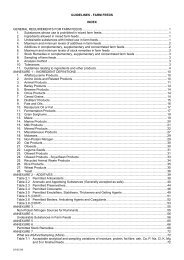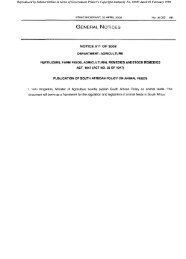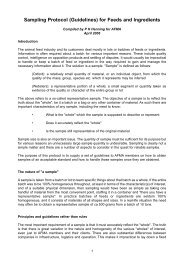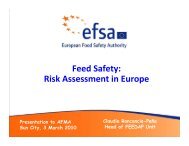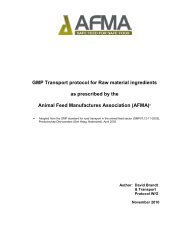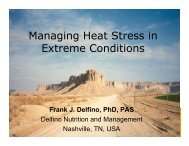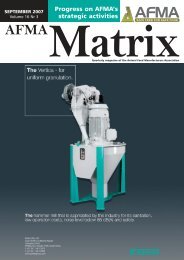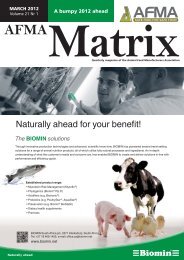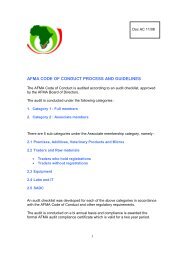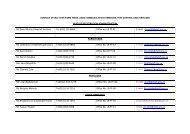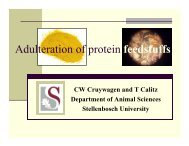You also want an ePaper? Increase the reach of your titles
YUMPU automatically turns print PDFs into web optimized ePapers that Google loves.
The impact of amino acid<br />
formulation on the dairy cow<br />
By TP Tylutki, PhD Dpl ACAN, AMTS LLC, USA<br />
What does a cow need to<br />
survive, reproduce, grow<br />
and produce milk? Typically<br />
the answers would<br />
be energy, protein, fat<br />
and minerals/vitamins. But let’s take a step<br />
back and look where these come from.<br />
Energy in the cow is going to come from<br />
fermentable carbohydrates, fatty acids, and<br />
the biggest one, volatile fatty acids (VFAs),<br />
from the rumen. The rumen takes all these<br />
fermentable products and the rumen microbes<br />
produce VFAs. These VFAs are used<br />
to produce glucose and fat (both body fat<br />
and milk fat). Protein is more difficult.<br />
Supply<br />
Everyone is used to the terms crude protein,<br />
soluble protein, degradable protein and<br />
non-degradable protein. None of these are<br />
correct though. The underlying problem is<br />
that animals do not use protein. Protein is<br />
a collective term for nitrogen-containing<br />
compounds. When feed is sent to the laboratory<br />
for analysis, they do not analyse for<br />
protein. Rather, they analyse for nitrogen.<br />
This methodology goes all the way back to<br />
the developer, Johan Kjeldahl, in 1883.<br />
There are a couple of newer methods<br />
commercially used that rely on combustion<br />
to determine how much nitrogen is<br />
in a sample, but the resulting compound<br />
(nitrogen) quantified is the same. It is then<br />
assumed that all proteins contain 16% nitrogen.<br />
This is not true either. A product<br />
such as maize protein may contain 16%<br />
nitrogen, milk 15,7% and wheat 17,5%. A<br />
great example of this is urea. Urea is 46% nitrogen.<br />
Using the standard 6,25 multiplier,<br />
this gives a crude protein of 287,5%.<br />
What should be measured, is either total<br />
amino acids or each amino acid AND ammonia<br />
nitrogen. Commercially this is not<br />
viable as it is cost-prohibitive. The cost per<br />
sample to do amino acids instead of crude<br />
protein, is between 15 and 20 times higher.<br />
Table 1: Amino acid composition of tissue, milk, microbes and several<br />
feeds (g/100g)<br />
Amino<br />
acid<br />
Tissue Milk Microbes Soya<br />
48<br />
Blood Alfalfa Maize<br />
gluten meal<br />
60<br />
MET 1,82 2,71 2,68 1,30 1,07 0,73 2,09<br />
LYS 6,29 7,62 8,20 6,49 9,34 6,02 1,24<br />
HIS 2,45 2,74 2,69 2,69 6,45 2,62 2,45<br />
PHE 3,65 4,75 5,16 5,22 7,86 6,32 6,48<br />
TRP 1,18 1,51 1,63 1,41 1,88 1,84 0,37<br />
THR 3,83 3,72 5,59 4,83 4,73 5,00 2,93<br />
LEU 6,96 9,18 7,51 8,66 13,40 9,26 16,22<br />
ILE 2,94 5,79 5,88 3,99 0,88 6,01 4,34<br />
VAL 4,28 5,89 6,16 4,39 9,08 7,14 5,04<br />
ARG 6,65 3,40 6,96 7,74 5,01 6,39 3,17<br />
Figure 1: Overview of amino acid flow in cattle<br />
48 <strong>AFMA</strong> MATRIX ● APRIL <strong>2013</strong>



